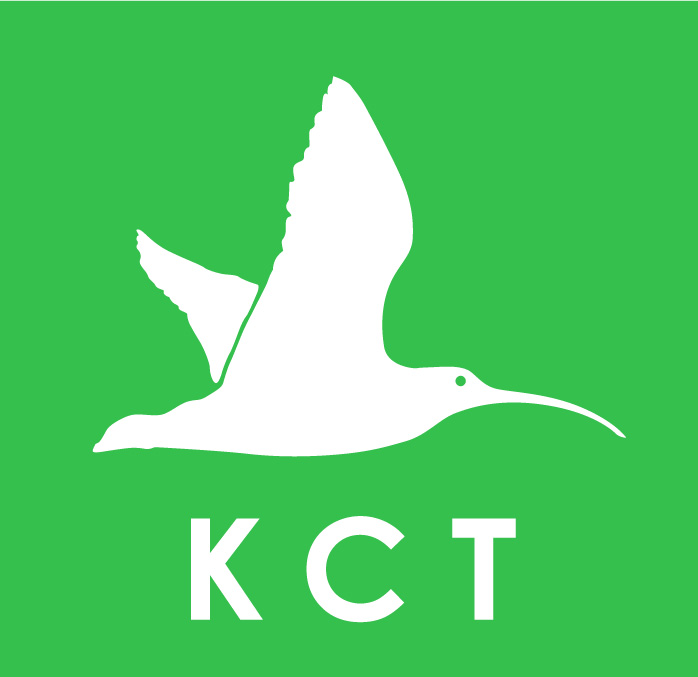|
The Trust assists in the management of around 330 acres (134 ha) of grassland, comprising different types, each with distinctive plant communities and requiring different husbandry. The main examples are as follows.
This type of grassland is found on shallow lime-rich soils generally overlying limestone rocks. Since 1950, 97% of this pasture has been lost across Britain, and for this reason Lowland Calcareous Grassland has been designated as a Priority Habitat under the UK Biodiversity Action Plan (BAP). Because it is ‘unimproved’ (never treated with inorganic fertiliser) it supports a very rich flora and invertebrate fauna, including many nationally rare and scarce species. It also provides feeding or breeding habitat for a number of scarce or declining birds including skylark, a BAP Priority Species.
|
Roundhill SSSI
An example of this type of grassland is Roundhill – a complex of 3 south-facing fields on the middle slopes of Bredon Hill extending over 20 acres (8 ha). It is owned by Kemerton Estate. The centre field is particularly species-rich and has been designated a Site of Special Scientific Interest (SSSI) for its limestone flora. It supports an abundance of attractive flowers, including pyramidal orchid, fairy flax, quaking grass, rock-rose and mouse-ear hawkweed. The grassland attracts a large number and variety of butterflies including meadow brown, marbled white, ringlet, gatekeeper, common blue and brown argus. All three fields are managed as ‘pasture’ and are grazed at a low density by cattle during the late spring and summer. No fertilizers or pesticides are used, and roguing – the control of weeds by hand – is sometimes necessary. The Trust has assisted in the management of this site for more than 20 years and in that time there has been a noticeable improvement of the flora in the two outer fields – one of the Site Management Plan’s key aims. |
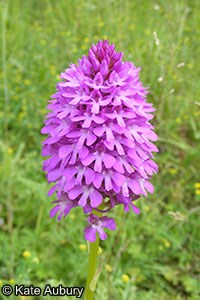 Pyramidal orchid, KLNR Pyramidal orchid, KLNR
|
Back to Top
This type of pasture is a subdivision of the UK BAP Priority Habitat Lowland Meadows. It is an increasingly rare habitat, occurring on free-draining soils, and characterised by a low proportion of rye grasses coupled with a wide range of other grass species.
Squitterbrook
An example of this type of grassland is a 3 acre (1 ha) field called Squitterbrook in Kemerton, which is owned by the Overbury Estate and managed by the Trust. The sward and hedge bottoms contain a rich variety of plants, including crested dog’s tail, sheep’s fescue, green-flowered helleborine, bee orchid, lady’s bedstraw, red clover, cowslip, and meadowsweet. The pasture is home to many bird and animal species, including the BAP Priority Species barn owl. It is managed traditionally, by summer grazing and occasional cutting. Control of ragwort, dock and creeping thistle is carried out by a combination of topping, roguing, and occasional spot-spraying. |
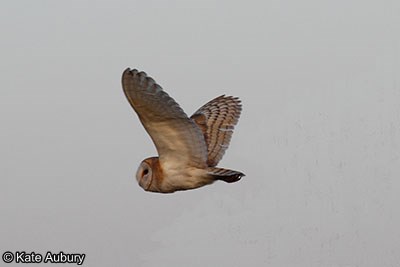 Barn owl hunting over Squitter Brook field Barn owl hunting over Squitter Brook field
|
Back to Top
Unimproved seasonally-flooded grassland, or flood meadow, is another subdivision of the UK BAP Priority Habitat Lowland Meadows. This type of grassland includes the well-known but now very rare ‘Lammas meadows’, which are shut up for hay in early spring, cropped in July, and grazed communally after Lammas Day on 1st August. Nutrients are supplied by flooding episodes in winter. Less than 3,700 acres (1,500 ha) of flood meadow now exist in the United Kingdom. The Trust owns 50 acres (20 ha) of flood meadow including parts of Upton Ham SSSI, Twyning Ham SSSI, and Asham Meadow, Birlingham. It oversees a further 103 acres (42 ha), including additional parts of Upton Ham and Brookfield Meadows LWS. Together, this represents approximately 4.1% of the entire national resource.
Back to
Top
| Twyning Ham SSSI
The Trust owns land at Twyning Ham SSSI (also known as Upham Meadow), a 257 acre (104 ha) Lammas meadow on the banks of the Avon which floods regularly during the year. The Trust’s land totals 17 acres (7 ha) and is strategically located in two strips running across the centre of the ham. The grassland is dominated by the plant community defined as MG4 in the National Vegetation Classification, which is characterized by the presence of greater burnet. The Trust’s parts of the meadow are managed traditionally, being cut for hay in July, and grazed communally after Lammas Day. The meadow supports important breeding populations of wading birds such as redshank, oystercatcher and curlew. It is home to rare plants including fine-leaved water dropwort and mouse-tail. |
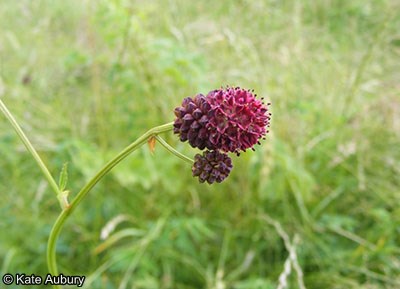 Greater Burnet Greater Burnet
|
|
Hay meadow is a further subdivision of the UK BAP Priority Habitat Lowland Meadows, and is characterized by a diverse and colourful flora. In early summer, it is carpeted with bulbous buttercup, meadow buttercup and creeping buttercup, interspersed with characteristic plants such as quaking grass, hairy sedge, lady’s bedstraw, yellow rattle, and adder’s-tongue fern. Hay meadow is an important habitat for skylark and a number of other farmland birds.
Long Meadow Local Wildlife Site
Long Meadow LWS in Kinsham is a species-rich old hay meadow owned by Kemerton Estate. In 1987, traditional management was re-introduced to the meadow after a period of intensification. The hay is cut in July – later than usual in modern farming – allowing flowers to set seed. The aftermath is grazed by sheep. This regime has brought about a significant improvement in plant biodiversity, thanks in part to the spread of yellow rattle, a plant which parasitizes and suppresses more dominant grass species.
Back to
Top |
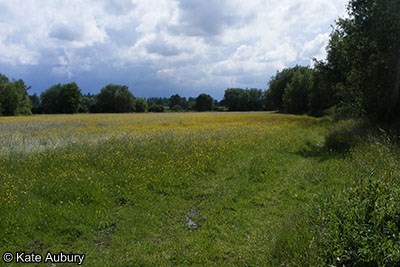 Long Meadow Local Wildlife Site Long Meadow Local Wildlife Site
|
Back to Map
|








